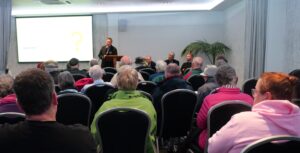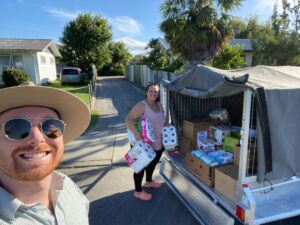“Strong urine” coloured water has led Ngātea residents to have brown stains on their laundry and switch to bottled water.
Residents have complained to Hauraki District Council about the brown water from their taps in Ngātea and other Hauraki Plains homes in recent months, and are now demanding a long-term solution.
However, council says the water is safe to drink, and health and safety has never been an issue.
Ngātea resident Carole Rudd told The Profile there was “no way” she would’ve attempted to drink the “strong urine” coloured water.
“The council insists that it’s drinkable but I don’t want to try and drink a glass of water that looks like somebody’s urine,” she said.
“In the end I got fed up and I bought a water filter for the kitchen, but of course that doesn’t affect the washing machine or the bathroom.”
The retired primary school teacher said although council gave her “special” laundry powder, she had to throw away some of her towels after brown water left them stained after washing.
“I was angry because even though it was a couple of hand towels and a pillowcase and it didn’t break the bank, I thought why should I have to do that because I’ve washed them?”
Carole believed brown water had been an ongoing problem in Ngātea for several years but this was the worst she had ever seen.
“It was like a third world country as far as I’m concerned, I may as well have walked down the road and tried to do my washing in the river. Since this incident, I’ve had to try and remember to turn the water taps on in the laundry to check first before I do any washing.”
Carole said she had brown water four or five times over the 10 years she’d lived there and always noticed other residents’ complaints on social media.
“If somebody complains, [council] try and flush the pipes, and normally I’ve never bothered because it’s Ngātea and you get brown water when it rains or when people do work on water pipes,” she said.
“It’s only when it got to this stage [in August] it was just too much – that [water] colour was beyond a joke.”
Carole said she visited council with her complaint and a worker immediately visited her address to flush the water pipes in her home.
“Even [the worker] said it was the worst he’d ever seen, he couldn’t understand why it had happened because we hadn’t had heavy rain and there was no one working in the area.
“But then the council never rings you back and says we found out it was whatever and we’ve fixed it, I just wish the council would sort out the waterworks.”
Susan Goodwin, who also lives in Ngātea, said she was also left with stained items after brown water in her home in July, and she was also hesitant to drink it.
“We are now purchasing bottled water to drink and I have grandsons who come over and I won’t let them have a bath,” she said.
A council worker had previously visited her home to flush her pipes when she had brown water but she had no response from council after lodging her brown water complaint back in July, she said.
“When the council workers flushed the pipes, we had to turn on our tap, which is on our side of the metre, to flush the lines coming into the house,” she said.
“We’ve done this on several occasions and the council worker has actually come out and put a flushline in now so we can do it ourselves but I really don’t feel that it’s up to us to rectify the matter. “I just wish the council would do something about it and at least admit there is a problem with what’s coming through and get back to me with a resolution. Our water rates are very high on the Hauraki Plains and I think we deserve drinkable water.”
Hauraki District Council told The Profile brown water was caused by high levels of manganese and iron in the water supply.
The water, collected from the Waihōu River and Mangatarata Stream, is treated at the Kerepēhi and Waitakaruru water treatment plants. “Council does treat the raw water to remove as much manganese as possible, though some does make it into our pipes,” council said.
“Due to the variable nature of the manganese and water use in the Plains, it can mean that we do have periods when manganese oxidises and causes the water to turn brown.”
Council said while the brown water is off-putting for many, the water was safe to drink and health and safety had never been an issue. “Treated water gets tested every day before leaving the treatment plant and the quality needs to conform to the National Drinking Water Standards,” council said.
“Our treatment plants are automated and will shut down if the treated water does not meet with these standards for safe drinking water.
“The laundry powder is given to affected residents when requested for removing of stains. We are onto our third 20kg bag over the last eight to 10 years.”
The Profile asked the council how many complaints it had received about the brown water but council did not provide an answer.
Council said it was investigating long-term solutions to the brown water including replacing older pipes in the network, making improvements to treatment plants to remove more manganese and increasing its pipe-cleaning programme.




